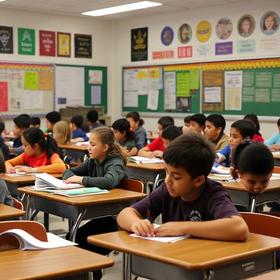Top Rankings
Regional School Unit 40/Maine School Administrative District 40 ranks among the top 20% of public school district in Maine for:
Category
Attribute
Community Size
Largest student body (number of students) (Top 1%)
For the 2025-26 school year, there are 4 public preschools serving 877 students in Regional School Unit 40/Maine School Administrative District 40. This district's average pre testing ranking is 2/10, which is in the bottom 50% of public pre schools in Maine.
Public Preschools in Regional School Unit 40/Maine School Administrative District 40 have an average math proficiency score of 43% (versus the Maine public pre school average of 52%), and reading proficiency score of 82% (versus the 82% statewide average).
Minority enrollment is 8% of the student body (majority Hispanic), which is less than the Maine public preschool average of 14% (majority Black).
Overview
This School District
This State (ME)
# Schools
7 Schools
259 Schools
# Students
1,782 Students
59,048 Students
# Teachers
171 Teachers
5,438 Teachers
Student-Teacher Ratio
10:1
10:1
Student By Grade
District Rank
Regional School Unit 40/Maine School Administrative District 40, which is ranked within the bottom 50% of all 182 school districts in Maine (based off of combined math and reading proficiency testing data) for the 2022-2023 school year.
The school district's graduation rate of 82% has decreased from 85-89% over five school years.
Overall District Rank
#121 out of 189 school districts
(Bottom 50%)
(Bottom 50%)
Math Test Scores (% Proficient)
44%
49%
Reading/Language Arts Test Scores (% Proficient)
84%
84%
Science Test Scores (% Proficient)
36%
37%
Graduation Rate
82%
86%
Students by Ethnicity:
Diversity Score
0.13
0.26
% American Indian
n/a
1%
% Asian
1%
1%
% Hispanic
2%
3%
% Black
n/a
5%
% White
93%
86%
% Hawaiian
n/a
n/a
% Two or more races
4%
4%
All Ethnic Groups
District Revenue and Spending
The revenue/student of $19,343 in this school district is less than the state median of $21,600. The school district revenue/student has stayed relatively flat over four school years.
The school district's spending/student of $17,309 is less than the state median of $21,191. The school district spending/student has stayed relatively flat over four school years.
Total Revenue
$35 MM
$3,617 MM
Spending
$31 MM
$3,549 MM
Revenue / Student
$19,343
$21,600
Spending / Student
$17,309
$21,191
Best Regional School Unit 40/Maine School Administrative District 40 Public Preschools (2025-26)
School
(Math and Reading Proficiency)
(Math and Reading Proficiency)
Location
Quick Facts
Rank: #11.
Prescott Memorial School
(Math: 60-69% | Reading: ≥90%)
Rank:
Rank:
9/
Top 20%10
100 Waldoboro Road
Washington, ME 04574
(207) 845-2424
Washington, ME 04574
(207) 845-2424
Gr: PK-6 | 108 students Student-teacher ratio: 9:1 Minority enrollment: 8%
Rank: #22.
Union Elementary School
(Math: 50-59% | Reading: 85-89%)
Rank:
Rank:
8/
Top 30%10
1070 Heald Highway
Union, ME 04862
(207) 785-4330
Union, ME 04862
(207) 785-4330
Gr: PK-6 | 115 students Student-teacher ratio: 10:1 Minority enrollment: 5%
Rank: #33.
Warren Community School
(Math: 35-39% | Reading: 80-84%)
Rank:
Rank:
3/
Bottom 50%10
117 Eastern Road
Warren, ME 04864
(207) 273-2001
Warren, ME 04864
(207) 273-2001
Gr: PK-6 | 304 students Student-teacher ratio: 9:1 Minority enrollment: 8%
Rank: #44.
Miller School
(Math: 35-39% | Reading: 75-79%)
Rank:
Rank:
2/
Bottom 50%10
145 Kalers Corner Road
Waldoboro, ME 04572
(207) 832-2103
Waldoboro, ME 04572
(207) 832-2103
Gr: PK-6 | 350 students Student-teacher ratio: 10:1 Minority enrollment: 8%
Recent Articles

How Public Schools Support Students on Free / Reduced-Lunch Programs
Explore how U.S. public schools support students eligible for free or reduced-price lunch through nutrition, academic, and wraparound services in 2025.

Hidden Costs of Public Schools: Fees, Supplies & Extras
Explore the hidden costs in public schools—fees, supplies, extracurriculars—and how parents can plan for them in 2025.

Public School Funding 2025: What Families Should Know
Essential insights on public school funding in 2025—how it works, what’s changing, and what families should know to stay ahead.





